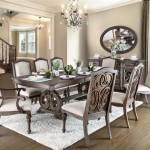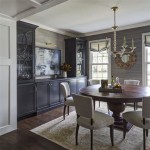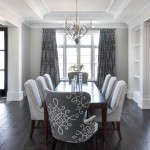The Dining Room Table with Settee: Redefining Dining Space Aesthetics and Functionality
The integration of a dining room table with a settee represents a shift in contemporary interior design, moving away from traditional matching chair sets towards a more relaxed, versatile, and visually interesting dining experience. This combination offers a blend of formality and informality, catering to a range of lifestyles and spatial constraints. This article will explore the benefits, considerations, and design possibilities associated with incorporating a dining room table with a settee into the home.
Historically, dining rooms were conceived as formal spaces, often reserved for special occasions and characterized by symmetrical arrangements and matching furniture. As open-concept living has become more prevalent, the dining area has evolved into a multi-functional space, serving as a place for meals, homework, games, and social gatherings. The dining room table with a settee reflects this evolution, providing a comfortable and adaptable seating option that responds to the dynamic needs of modern households.
The settee, also known as a banquette or bench, offers several distinct advantages over individual chairs. Its continuous seating surface can accommodate a larger number of people, especially in smaller spaces where individual chairs might create a cluttered appearance. Furthermore, a settee encourages a more communal dining experience, fostering conversation and connection among diners. Its upholstered surface provides enhanced comfort, allowing for longer, more enjoyable meals and gatherings.
Maximizing Space and Seating Capacity
One of the primary benefits of using a settee in conjunction with a dining room table is its ability to maximize space and seating capacity. In apartments and smaller homes, every square inch counts. A settee, typically placed against a wall, eliminates the need for space behind individual chairs, thus freeing up valuable floor area. This configuration can be particularly beneficial in galley kitchens or dining areas that share space with living rooms.
Moreover, a settee can often accommodate more people than the equivalent number of individual chairs. While the number of chairs is fixed, a settee can squeeze in an extra guest or two, making it ideal for families with children or those who frequently entertain. The long, uninterrupted seating surface also creates a more visually streamlined and less cluttered look.
Considerations for optimizing space include the depth of the settee and its positioning relative to the table. A settee that is too deep can make it difficult for diners to reach the table comfortably, while one that is too shallow may not provide adequate support. The ideal depth typically ranges from 18 to 24 inches. Furthermore, ensuring sufficient legroom beneath the table is crucial for a comfortable dining experience. The table height should be appropriately matched to the settee's seat height, with a clearance of approximately 10 to 12 inches between the seat and the table's underside.
The length of the settee should also be carefully considered. It should ideally extend beyond the length of the table to create a balanced and visually appealing arrangement. Alternatively, two smaller settees can be placed on opposite sides of the table, creating a more symmetrical and formal look.
Enhancing Style and Design Flexibility
Beyond its functional benefits, a dining room table with a settee offers significant advantages in terms of style and design flexibility. A settee can serve as a focal point in the dining area, adding visual interest and personality to the space. It provides an opportunity to introduce color, texture, and pattern, creating a more inviting and aesthetically pleasing environment.
The design options for settees are virtually limitless. They can be upholstered in a wide range of fabrics, from luxurious velvets and silks to durable linens and cottons. The choice of fabric can significantly impact the overall aesthetic of the dining area, allowing for customization to suit individual tastes and preferences. For instance, a brightly colored settee can add a pop of vibrancy to a neutral space, while a settee upholstered in a textured fabric can create a sense of warmth and comfort.
Furthermore, the settee's legs can be customized to complement the style of the dining table and the overall decor of the room. Options include sleek metal legs for a modern look, turned wood legs for a traditional aesthetic, or tapered legs for a more minimalist design. The addition of decorative details, such as tufting, piping, or nailhead trim, can further enhance the settee's visual appeal.
The combination of a dining room table with a settee also allows for greater flexibility in seating arrangements. While the settee provides a fixed seating option on one side of the table, individual chairs can be used on the other sides. This creates a visually dynamic and functionally versatile arrangement, allowing for easy adjustments to accommodate different numbers of diners. The chairs can be chosen to complement the settee's fabric and style, creating a cohesive and harmonious look. Alternatively, mismatched chairs can be used to create a more eclectic and personalized aesthetic.
The shape of the settee can also contribute to the overall design of the dining area. While rectangular settees are the most common, curved or L-shaped settees can be used to create a more intimate and inviting dining space. A corner settee is particularly well-suited for smaller dining areas, as it maximizes seating capacity while minimizing floor space.
Creating a Comfortable and Inviting Dining Experience
The ultimate goal of any dining space is to create a comfortable and inviting environment for meals and gatherings. A dining room table with a settee can significantly contribute to this goal by providing comfortable seating and fostering a sense of community. The upholstered surface of the settee offers a more comfortable and supportive seating experience than traditional wooden chairs, allowing for longer and more enjoyable meals.
The addition of cushions and pillows can further enhance the comfort of the settee. These can be chosen to complement the settee's fabric and style, adding visual interest and personality to the space. Scatter cushions provide additional support and comfort, while decorative pillows can add a pop of color or pattern.
The height and depth of the settee are crucial factors in ensuring a comfortable dining experience. A settee that is too low or too shallow may not provide adequate support, while one that is too high or too deep can make it difficult for diners to reach the table comfortably. The ideal seat height for a dining settee is typically around 18 inches, while the ideal depth is between 18 and 24 inches.
Lighting also plays a crucial role in creating a comfortable and inviting dining environment. Overhead lighting, such as a chandelier or pendant light, can provide ambient illumination, while task lighting, such as sconces or table lamps, can provide focused light for reading or other activities. Dimmable lighting allows for adjustments to the brightness to create the desired mood and ambiance.
The addition of a rug beneath the dining table and settee can also enhance the comfort and aesthetics of the dining area. A rug can define the dining space, add warmth and texture, and absorb sound, creating a more pleasant and intimate atmosphere. The size of the rug should be large enough to accommodate all of the seating and the table, with at least 24 inches of rug extending beyond the edges of the furniture.
Finally, the overall layout of the dining area should be carefully considered to ensure a comfortable and functional space. Sufficient space should be provided around the table and settee to allow for easy movement and access. The placement of other furniture, such as sideboards or buffets, should be carefully planned to avoid creating a cluttered or cramped environment. The goal is to create a dining space that is both visually appealing and functionally efficient, providing a comfortable and inviting environment for meals and gatherings.
In conclusion, integrating a dining room table with a settee offers a multitude of benefits, from maximizing space and seating capacity to enhancing style and creating a comfortable dining experience. Careful consideration of design elements, spatial constraints, and personal preferences is crucial for achieving a harmonious and functional dining space that reflects individual tastes and lifestyles.

Hayward 6 Piece Brown Dining Set Table 4 Tall Back Chairs And Settee Dgc500sl6pc The Home

Cozy Up To A Loveseat At The Table

Header Settees And Dining Tables Kitchen Seating Home Decor Room Table

Look Inside An Early 20th Century Shingle Style Getaway In The Hamptons Dining Room Design Kitchen Banquette Upholstered

Gray Leather Wingback Settee At Oval Trestle Table Transitional Dining Room

Living Room Meets Dining The New Way To Eat In

Franklin Dining Room Set W Upholstered Chairs And Settee Elements Furniture Cart

Bring Elegance To Your Home With Dining Banquettes Settees

Wednesday Watch List Dining Room Trends Settee Home Decor

The Best 7 Ways To Incorporate A Sofa In Dining Room








